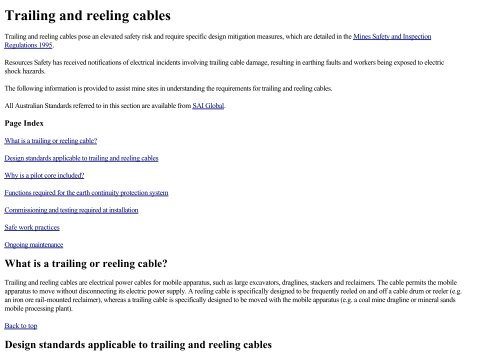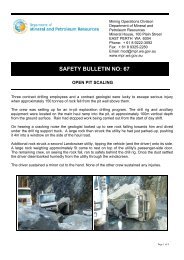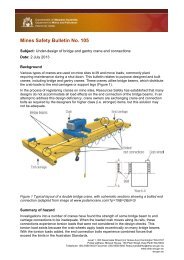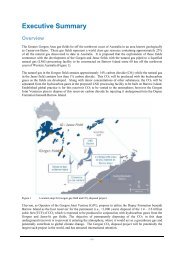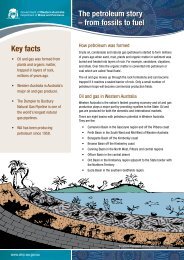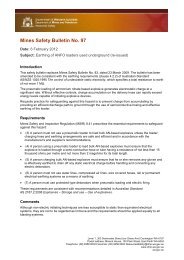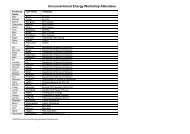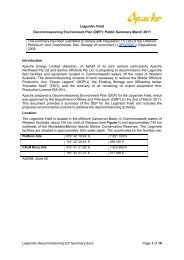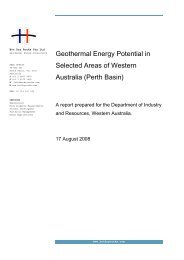Trailing and reeling cables
Trailing and reeling cables
Trailing and reeling cables
Create successful ePaper yourself
Turn your PDF publications into a flip-book with our unique Google optimized e-Paper software.
<strong>Trailing</strong> <strong>and</strong> <strong>reeling</strong> <strong>cables</strong><br />
<strong>Trailing</strong> <strong>and</strong> <strong>reeling</strong> <strong>cables</strong> pose an elevated safety risk <strong>and</strong> require specific design mitigation measures, which are detailed in the Mines Safety <strong>and</strong> Inspection<br />
Regulations 1995.<br />
Resources Safety has received notifications of electrical incidents involving trailing cable damage, resulting in earthing faults <strong>and</strong> workers being exposed to electric<br />
shock hazards.<br />
The following information is provided to assist mine sites in underst<strong>and</strong>ing the requirements for trailing <strong>and</strong> <strong>reeling</strong> <strong>cables</strong>.<br />
All Australian St<strong>and</strong>ards referred to in this section are available from SAI Global.<br />
Page Index<br />
What is a trailing or <strong>reeling</strong> cable?<br />
Design st<strong>and</strong>ards applicable to trailing <strong>and</strong> <strong>reeling</strong> <strong>cables</strong><br />
Why is a pilot core included?<br />
Functions required for the earth continuity protection system<br />
Commissioning <strong>and</strong> testing required at installation<br />
Safe work practices<br />
Ongoing maintenance<br />
What is a trailing or <strong>reeling</strong> cable?<br />
<strong>Trailing</strong> <strong>and</strong> <strong>reeling</strong> <strong>cables</strong> are electrical power <strong>cables</strong> for mobile apparatus, such as large excavators, draglines, stackers <strong>and</strong> reclaimers. The cable permits the mobile<br />
apparatus to move without disconnecting its electric power supply. A <strong>reeling</strong> cable is specifically designed to be frequently reeled on <strong>and</strong> off a cable drum or reeler (e.g.<br />
an iron ore rail-mounted reclaimer), whereas a trailing cable is specifically designed to be moved with the mobile apparatus (e.g. a coal mine dragline or mineral s<strong>and</strong>s<br />
mobile processing plant).<br />
Back to top<br />
Design st<strong>and</strong>ards applicable to trailing <strong>and</strong> <strong>reeling</strong> <strong>cables</strong>
Regulation 5.21 requires that trailing <strong>and</strong> <strong>reeling</strong> <strong>cables</strong> must conform to Australian St<strong>and</strong>ard AS 2802 <strong>and</strong> incorporate a pilot core arranged to cut off the supply of<br />
electricity in the event of a break in the earthing circuit.<br />
Note: There are currently no underground coal mines in Western Australia so AS 1802 does not apply.<br />
Once an earth continuity relay <strong>and</strong> associated connections of the protection system are installed, the pilot core allows pilot earth loop or earth continuity monitoring<br />
protection to function.<br />
Back to top<br />
Why is a pilot core included?<br />
The inclusion of a pilot core allows pilot earth loop or earth continuity monitoring protection to function. It is important to realise, though, that this protection method is<br />
not the same as pilot wire differential protection (where the current entering <strong>and</strong> leaving a cable is measured <strong>and</strong> compared).<br />
Rather, earth continuity protection functions by establishing a loop current through the pilot core, returning through the cable earth. This is typically achieved using an<br />
earth continuity protection relay to apply a low voltage DC signal between the pilot <strong>and</strong> earth of the cable. By measuring this signal, the resistance of the circuit can be<br />
determined <strong>and</strong> protection operation initiated for variance from a pre-tested value. This variance is indicative of a break in the earth return path of the cable, <strong>and</strong><br />
possibly the cable itself. With this arrangement, an end-of-line resistor is required to avoid a short circuit between the pilot cable <strong>and</strong> the earth.<br />
Back to top<br />
Functions required for the earth continuity protection system<br />
For the overall earth continuity protection arrangement, the system must perform the functions listed below.<br />
• The protection system must monitor the status of the earth continuity for any break in the earth return path. Typically, this will require a status indication of earth<br />
continuity healthy, open-circuit or short-circuit.<br />
• In the event that the status of the pilot earth continuity circuit is open-circuit or short-circuit, an interlock must immediately initiate automatic de-energisation of the<br />
mobile apparatus.<br />
• When a fault does occur, the system should require manual reset — the system should latch <strong>and</strong> thereby store the fault condition in order to prompt fault-finding<br />
<strong>and</strong> testing.<br />
• The protection system should ideally interface with the control system of the mobile apparatus such that a healthy status indication for the pilot cable is required<br />
prior to start.<br />
Back to top<br />
Commissioning <strong>and</strong> testing required at installation<br />
Earth continuity protection must be installed, commissioned <strong>and</strong> tested in accordance with the manufacturer’s instructions <strong>and</strong> recommendations. Regulation 5.21 also
equires that these instructions <strong>and</strong> recommendations conform to AS 1747.<br />
Regulations 5.13 <strong>and</strong> 5.14 require that records <strong>and</strong> details of electrical installing work carried out at the mine are recorded in the electrical log book. This includes<br />
commissioning check sheets <strong>and</strong> test records, which must be kept — make an entry in the logbook indicating where they can be found. The earth continuity protection<br />
relay itself should have a label affixed indicating the test date <strong>and</strong> who conducted the tests, including company details.<br />
Back to top<br />
Safe work practices<br />
Regulations 5.19 <strong>and</strong> 5.21 require trailing <strong>and</strong> <strong>reeling</strong> <strong>cables</strong> to be installed, located, supported <strong>and</strong> protected in a way that:<br />
• minimises the risk of damage to the cable <strong>and</strong> to any connecting or coupling device<br />
• does not obstruct any access way (this may include a pit roadway)<br />
• separates the cable from other services at the mine.<br />
In practice, this may require the use of protective berms <strong>and</strong> the use of visible markers for trailing <strong>cables</strong>.<br />
Back to top<br />
Ongoing maintenance<br />
Regulation 5.27 requires mines to have an appropriate maintenance system in place to ensure that electrical equipment <strong>and</strong> installations are maintained in safe working<br />
order.<br />
In this regard, a routine maintenance system must be implemented for testing earth continuity protection systems to confirm the integrity of the system <strong>and</strong> the pre-tested<br />
pilot <strong>and</strong> earth loop resistance value. This is critical because the system relies on the accuracy of this pre-tested value.<br />
For surface operations, routine testing should be done every three months. For quarries, dredges (other than a floating treatment plant) <strong>and</strong> underground mines, this test<br />
must be done every month.<br />
Back to top<br />
Page last modified: 14-May-2013<br />
PDF | Print | Share


